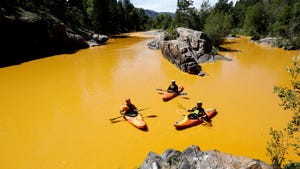The Environmental Protection Agency mistakenly released 3 million
gallons of toxic waste water from an abandoned mine into Colorado's
Animas River. That number is three times its original estimate.
VPC
The mine continues to discharge 500 gallons per minute, EPA Region 8 administrator Shaun McGrath said in a teleconference call Sunday afternoon, but the polluted water is being contained and treated in two ponds by the site of the spill near Silverton, Colo.
According to preliminary testing data the EPA released Sunday, arsenic levels in the Durango area of the Animas River were, at their peak, 300 times the normal level, and lead was 3,500 times the normal level. Officials said those levels have dropped significantly since the plume moved through the area.
Both metals pose a significant danger to humans at high levels of concentration.
"Yes, those numbers are high and they seem scary," said Deborah McKean, chief of the Region 8 Toxicology and Human Health and Risk Assessment. "But it's not just a matter of toxicity of the chemicals, it's a matter of exposure."
She said the period of time those concentrations remain in one area is short.
Earlier Sunday the city of Durango, Colo., and La Plata County, Colo., declared a state of emergency. The Navajo Nation Commission on Emergency Management also issued a state of emergency declaration in response to the spill.
EPA officials said in the teleconference Sunday afternoon that water quality experts have been deployed to Shiprock and are encouraging people there to take advantage of water quality sampling.
EPA officials said they are also working to provide necessary materials to people in Farmington and Aztec for private well sampling.
New Mexico Environment Department spokeswoman Allison Scott-Majure said testing has not yet been performed in San Juan County.
In San Juan County, restrictions are still in effect along the Animas River, said County Executive Officer Kim Carpenter. The biggest obstacle, he said, is making sure residents and livestock have access to drinking water.
Carpenter said people and their pets should avoid contact with the river, livestock should not be allowed to drink the water and people should not catch fish in the river. He also instructed people to avoid contact with the wildlife along the river in Berg Park, as information on the chemicals in the water is still being released.
In Sunday's teleconference, McGrath said the EPA is looking at the next steps for cleaning up the site.
"We're working to see if we can get this on the National Priorities List for designation as a SuperFund cleanup site," McGrath said.
He qualified the statement a moment later, saying, "It's one option that can be considered."
Such a designation would establish the area as an abandoned hazardous waste site and unlock federal funds to implement a comprehensive cleanup plan.
As the city of Durango, Colo., and La Plata County, Colo., declared a state of emergency early Sunday, La Plata County Manager Joe Kerby said the decision stemmed from the "serious nature of the incident."
Later in the day, the Navajo Nation Commission on Emergency Management issued a state of emergency declaration in response to the spill.
Abasta said Begaye and Vice President Jonathan Nez toured the Gold King Ming Sunday. He said Abasta was likely to sign it.
At 27,000 square miles, the Navajo Nation is comparable in size to West Virginia.
Begaye told the Daily Times that he had directed Navajo Nation Attorney General Ethel Branch to assemble a legal team to file a lawsuit against the EPA.
"They are impacting the livelihood of our people," he said.
Begaye said he was disappointed with the EPA's lack of information and disclosure about the types of toxic metals that were discharged into the Animas and San Juan rivers.
Navajo Nation Council Speaker LoRenzo Bates told the Daily Times that residents were concerned about drinking water safety, river access, water for livestock and crops, and the possibility of compensation for failed crops. With irrigation canals shut off, many farmers are concerned about their next step, Bates said.
The Navajo Tribal Utility Authority (NTUA) warned residents to stay away from the river and to refrain from using its water for livestock and other household needs. But it said communities along the San Juan River get their drinking water from the city of Farmington, so it is safe for consumption.
Mustard-colored water flowed this week into Cement Creek, a tributary that runs through Silverton and into the Animas River. In New Mexico, the plume of pollution entered Aztec early Saturday morning and Farmington later that morning. Officials said they expected it to reach the Utah border on Monday and Lake Powell, in Arizona, late Wednesday.
New Mexico Gov. Susana Martinez said the state's first notification of the spill came from Southern Ute Tribe officials. "It's completely irresponsible for the EPA not to have informed New Mexico immediately," she said after flying over the affected rivers.
State Environment Secretary Ryan Flynn said the EPA did not notify his department of the spill until almost 24 hours after they'd caused it. He said the agency's initial response to the disaster was "cavalier and irresponsible."
Contributing: Greg Toppo, USA TODAY; KUSA-TV, Denver

